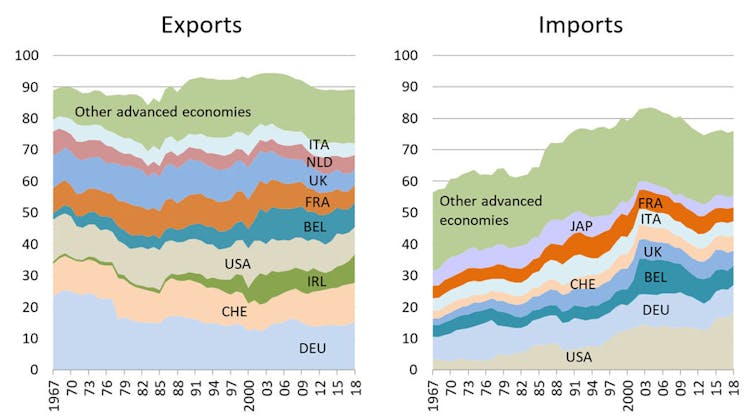.png)
Recent drug shortages in Europe overshadow half a century of trade surpluses
The Covid-19 shock led to shortages in essential drugs in many European countries, including France. Such insufficiencies are not new in the global pharmaceutical market, which is clearly dominated by advanced countries, and particularly those in Europe. China’s and India’s pharmaceutical-trade shares continue to overall only be modest, although they have been rising over time, and have become central for some products.
This advanced-country predominance has held for over half a century, as can be seen in the CHELEM database, which lists the values of bilateral trade flows in current US dollars for 71 product categories, going back to 1967. The “GF” product category here includes basic pharmaceutical products pertaining to organic chemistry (alkaloids, antibiotics, hormones, vitamins and so on) and pharmaceutical preparations (medicines, blood, vaccines etc.).
The breakthrough of Ireland and Belgium
Pharmaceuticals has been one of the most dynamic industries in terms of international-trade growth. Between 1967 and 2018, annual trade flows rose by an average of 11.7% at current prices (as compared to a figure of 9% p.a. for all goods). This growth rate is similar to that of electrical components (14% p.a.) and telecommunications equipment (12.4%). The share of pharmaceutical goods in international trade increased sharply from 1% in 1989 to 2.8% in 2003, and was 3.3% in 2018.
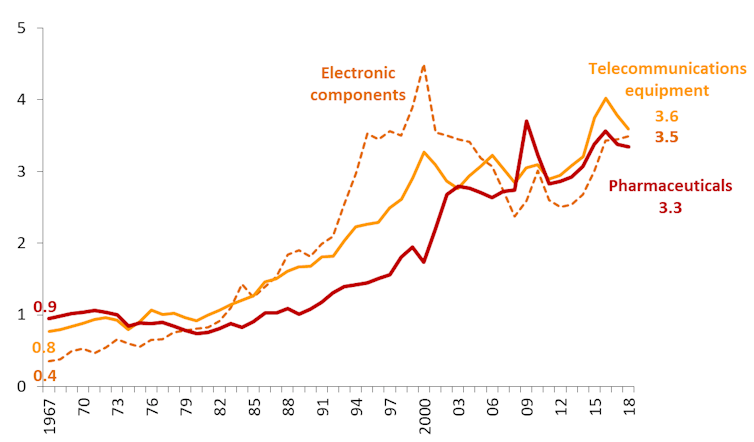
Since 1967, the share of pharmaceutical exports originating from advanced countries has hovered around 90%, with the EU-28 accounting for between 62% and 72% of world exports, and Germany, France, the United Kingdom, the Netherlands and Italy being significant exporters over the entire period (Figure 2, exports).
The shares of Ireland and Belgium in this trade skyrocketed in the 2000s. By 2018, Ireland was the third-largest exporter of pharmaceutical products (accounting for 9.1% of world exports), ranking just behind Germany (15%) and Switzerland (12%), but ahead of the United States (8.7%), itself followed closely by Belgium (7.8%). The sharp increase in Belgium’s share in world imports in 2002 can be entirely attributed to purchases from Ireland (Figure 2, imports).
Source: CEPII, CHELEM-International trade database, Author provided.
The spectacular rise of these two small EU member states with attractive tax systems owes much to the location decisions of multinational firms. These firms established affiliates in these countries, boosting local production and creating an intricate network of trade links across the Atlantic. Belgium has turned into a platform for the re-export of pharmaceutical products to not only the United States but also its European partners (mostly Germany). As for Ireland, its remarkable surplus hides sharp asymmetric movements in its European exports (mainly to Belgium, Germany and the United Kingdom): as exports to one country rise, they fall by the same amount to other European countries. The overall trend in Ireland is of a falling surplus toward Europe, matched by a rising surplus toward the United States (with figures of 4% of the world trade in pharmaceutical products in 2018 with each of these two trade partners).
In 2018, Belgium was the United States’ main customer (accounting for one tenth of US exports) while Ireland was the US’s main supplier (furnishing over 20% of US imports). The fiscal and industrial strategies of multinational companies within the US/Ireland/Belgium triangle inflate the share of the European Union in the global trade in pharmaceutical products.
The rise of emerging economies
Advanced countries have substantially increased their share of world imports: from 56% in 1967 to 76% in 2018 (See Figure 2). The United States on its own accounts for three-quarters of this 20 percentage-point rise. The European Union’s share in world imports, although below its share in world exports, remained at over 40% throughout the period (peaking at 57% in 2004).
India and China are the only emerging countries to play a significant role in the pharmaceutical trade (Figure 3), with shares that have been rising steadily since the mid-2000s. In 2018, India and China each accounted for 3% of global exports. China exports mainly to the European Union (14% of its sales), and then to India and the United States (9% each). India primarily sells to the United States (17%), and then to Africa (11%) and the European Union (7%).
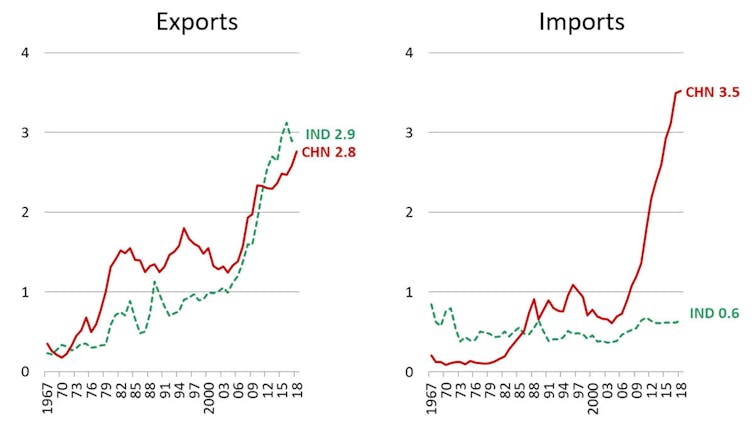
India’s small share of world imports has not varied much over the last 50 years – it was just 0.6% in 2018 (Figure 3, imports, above). However, its main import partner, which was previously Europe and the Commonwealth of Independent States (CIS) region, is now China, up from less than 1% of its purchases in 1979 to over 40% in 2018.
On the contrary, Chinese imports have been rising since 2005, especially since the Great Recession and the rebalancing of its growth toward domestic demand. The reform of China’s healthcare system has also played a role. Most Chinese pharmaceutical imports come from Europe (20% in 2018), far ahead of imports from the United States (6%).
The international fragmentation of production
The map of international pharmaceutical trade confirms the central position of Europe: in 2018, 46% of world trade in pharmaceuticals took place in the “Europe & CIS” region (39% originating from the EU, 6% from other European countries, and 1% from the CIS), while the figure for the intra-European share of all goods in world trade is only 29%. Europe also takes the lion’s share of inter-regional flows, mostly with the Americas (with this latter flow corresponding to 18% of world pharmaceutical trade) and then Asia & Oceania (9%). Less than one quarter of pharmaceutical trade originates from the rest of the world, with a figure for Asia & Oceania of barely 11% (as compared to their figure of 35% for aggregate trade).
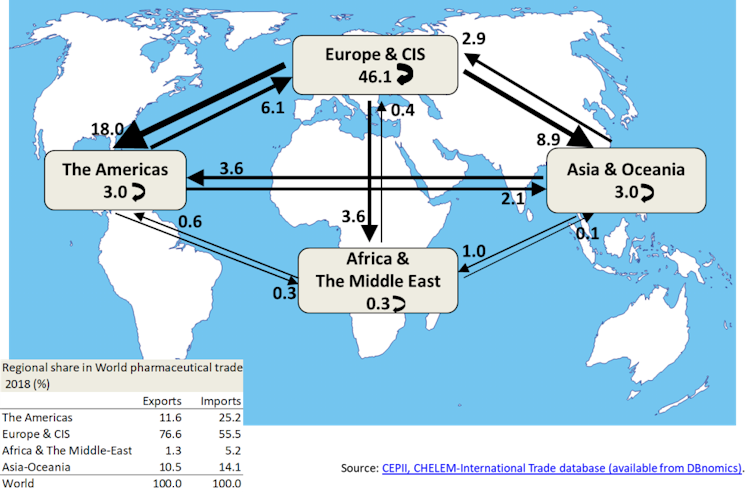
For over half a century, advanced countries have been running massive trade surpluses with respect to the rest of the world in the pharmaceutical sector. In 2018, their trade surplus was still 13% of the world trade in pharmaceutical goods, despite having dropped markedly between the late 1960s and early 2000s (Figure 4).
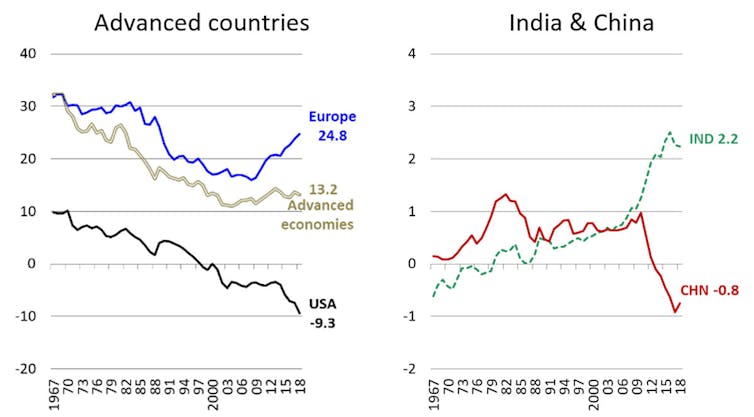
Source: CEPII, CHELEM-International Trade database, Author provided.
Among advanced countries, the experiences of the United States and Europe have diverged since the Great Recession: the trade balance worsened for the United States to reach a 9% deficit in 2018, while the fall in the European surplus has stopped, with a surplus figure that is now 25% of the world trade in pharmaceutical goods. The mirror image of the worsening of the US balance has been growing surpluses in Ireland, Switzerland and Germany vis-à-vis the United States.
Among the emerging countries, India’s surplus has been rising steadily, but remains relatively small (2% in 2018), while China’s trade balance has turned slightly negative with its rising imports (Figure 4).
Despite its substantial surplus (one quarter of world trade in pharmaceutical goods), Europe has in recent years faced growing supply difficulties, in part linked to the international fragmentation of production, the concentration of pharmaceutical firms, and the just-in-time inventory-management strategies of multinationals.
The sector is characterised by a high level of R&D investment; most innovative products are expensive, and margins remain high as long as the products are covered by patents. However, the low-cost production of generic drugs and active ingredients is being offshored to India and China. The Covid-19 pandemic and the shortages of some key medicinal products have revealed the weaknesses of the Old Continent, portraying Europe as a giant with feet of clay.
This article is republished from The Conversation under a Creative Commons license. Read the original article.

